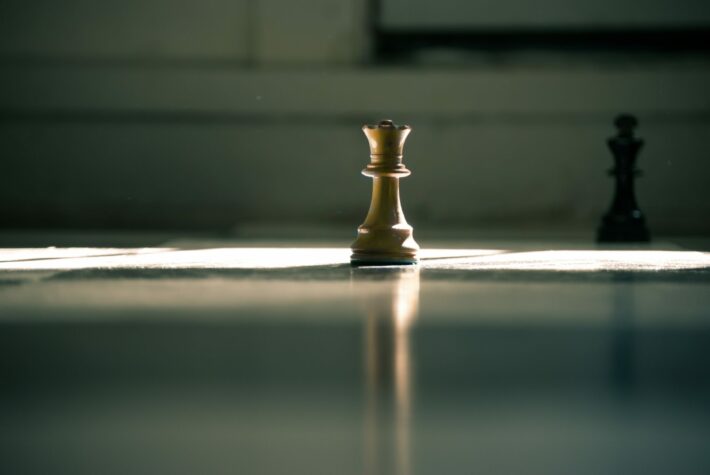In the intricate game of chess, the queen reigns supreme as a powerful and versatile piece. With her unparalleled range of movement, she holds the potential to shape the course of the game. Understanding the strategic moves of the queen is essential for aspiring chess players looking to master the complexities of the game.
This comprehensive guide explores the significance of the queen’s positioning, her impact on overall game dynamics, and the tactical maneuvers that can be employed to maximize her potential. Get ready to delve into the strategic realm of the queen in chess.
What are the legal moves for the queen in chess?
The queen in chess has powerful mobility, able to move horizontally, vertically, or diagonally across any number of empty squares. This grants her immense control over the chessboard. She can be considered the most versatile piece, as her range of movement allows her to swiftly navigate the game.
However, it’s crucial to be mindful of potential threats and carefully plan her moves to avoid being captured. Understanding the legal moves of the queen is essential for executing strategic maneuvers and setting up successful attacks in chess games.
What is the range of movement for the queen in chess?

The queen in chess possesses an impressive range of movement. She can travel any number of squares in horizontal, vertical, or diagonal directions. This grants her tremendous flexibility and enables her to swiftly reposition herself on the board. With her wide-ranging capabilities, the queen can cover significant distances and exert influence over various areas simultaneously.
Players must harness this extensive range wisely, considering both offensive and defensive possibilities, as the queen’s movements play a crucial role in shaping the dynamics of the game.
Can the queen move in any direction on the chessboard?
Yes, the queen can move in any direction on the chessboard—horizontally, vertically, or diagonally. This exceptional freedom of movement distinguishes the queen from other chess pieces and underscores her significance in gameplay.
Whether she needs to control important squares, launch an attack, or provide crucial defense, the queen’s ability to traverse the board in any direction empowers players to devise a wide array of strategies and tactics. Harnessing the queen’s versatile movement is key to achieving success in the game of chess.
How many squares can the queen move in a single turn?
The queen in chess can move any number of squares in a single turn, as long as her path is unobstructed by other pieces. This attribute grants her unparalleled mobility compared to other chess pieces. With the ability to traverse the board swiftly, the queen can swiftly shift her position, adapt to changing circumstances, and exert control over multiple areas simultaneously.
The freedom to cover significant distances in a single turn amplifies the queen’s strategic value and enhances a player’s options for both offense and defense.
What are the limitations of the queen’s movement in chess?
While the queen possesses remarkable freedom of movement in chess, there are a few limitations to consider. First, the queen cannot leap over other pieces, meaning her path must be clear to proceed. Additionally, she cannot move like a knight, making angled jumps.
These restrictions require players to plan the queen’s movements carefully and consider the positioning of other pieces on the board. However, despite these limitations, the queen remains an extremely powerful piece, capable of exerting substantial influence over the game.
Are there any specific rules for capturing the queen in chess?
When it comes to capturing the queen in chess, the rules are straightforward. The queen can capture any opponent’s piece that falls within her range of movement. This includes capturing enemy pawns, bishops, knights, rooks, and even the opponent’s queen.
By eliminating opposing pieces from the board, the queen helps tip the balance of power in the player’s favor. It is important, however, to consider the consequences of each capture, as well as the potential risks involved, to ensure a favorable outcome in the game.
How does the queen compare to other pieces in terms of mobility?
In terms of mobility, the queen reigns supreme among the chess pieces. Unlike the restricted movements of pawns, bishops, knights, and rooks, the queen can move freely in any direction—horizontally, vertically, or diagonally—across multiple squares.
This exceptional mobility grants the queen greater reach and allows her to swiftly respond to changing game situations. The queen’s versatility and vast range of movement make her a dominant force on the board, capable of executing diverse strategies and influencing the outcome of the game.
Can the queen jump over other pieces on the chessboard?
No, the queen cannot jump over other pieces on the chessboard. Unlike knights, who possess the ability to leap over obstacles, the queen’s movement is restricted to unobstructed paths. This means that there must be no pieces blocking her way in any direction she intends to move—be it horizontally, vertically, or diagonally.
Consequently, players must carefully consider the positions of other pieces when planning the queen’s movements to ensure she can maneuver efficiently and effectively across the board.
What strategies can be employed using the queen’s versatile moves?
The queen’s versatile moves open up a plethora of strategic possibilities in chess. She can be employed for various purposes, such as controlling critical squares, launching attacks on the opponent’s pieces, defending key areas, supporting pawn promotion, or initiating powerful combinations.
By utilizing the queen’s range of movement effectively, players can create tactical threats, establish dominant positions, and execute complex maneuvers. Mastering the art of leveraging the queen’s versatility is essential for devising winning strategies and gaining an advantage in the game of chess.
How does the queen contribute to attacking and defending in chess?

The queen is an invaluable asset when it comes to both attacking and defending in chess. With her remarkable mobility and ability to move in any direction, the queen can swiftly engage in offensive maneuvers, targeting vulnerable enemy pieces and launching devastating attacks.
Additionally, her presence on the board enhances defensive capabilities by offering powerful protection to the player’s forces and fortifying key squares. Skillfully employing the queen’s attacking and defensive potential can significantly influence the outcome of the game, making her an essential component of strategic play in chess.
Are there any special tactics or maneuvers involving the queen?
Special tactics and maneuvers involving the queen can greatly impact the outcome of a chess game. One such tactic is the queen sacrifice, where the queen is deliberately offered to gain a tactical advantage or set up a checkmate.
Other maneuvers include decoy tactics, where the queen is used to lure the opponent’s pieces into vulnerable positions, and double attacks known as queen forks, where the queen simultaneously attacks two enemy pieces. Mastering these special techniques involving the queen can provide players with valuable opportunities to outmaneuver their opponents and secure victory in the game of chess.
The table below shows the Special Tactics and Maneuvers Involving the Queen
| Scenario | Tactic/Maneuver | Description |
|---|---|---|
| Queen Sacrifice | Decoy Tactics | Using the queen to lure the opponent’s pieces into vulnerable positions. |
| Queen Fork | Double Attack | Simultaneously attacking two opponent’s pieces with the queen. |
| Queen Battery | Powerful Attacks | Aligning multiple queens on the same file, rank, or diagonal for devastating attacks. |
| Queen Outpost | Strategic Positioning | Placing the queen on an advantageous square to control key areas of the board. |
| Queen Endgame Technique | Queen vs. Pawn | Utilizing the queen’s mobility and coordination to promote a pawn and secure victory. |
What is the significance of the queen’s movement in chess strategy?
The queen’s movement holds great significance in chess strategy. Her ability to traverse the board horizontally, vertically, and diagonally grants her immense control over key squares and important lines of attack. By strategically positioning the queen, players can exert pressure on the opponent’s position, create threats, and disrupt their plans.
Moreover, the queen’s mobility allows for coordination with other pieces, contributing to the formation of powerful attacks or robust defenses. Understanding and leveraging the queen’s movement in chess strategy is essential for achieving a competitive advantage and executing successful game plans.
How does the queen’s movement pattern differ from other chess pieces?
The queen’s movement pattern differs from other chess pieces due to her remarkable versatility. Unlike the limited range of movement for pieces like pawns, bishops, knights, and rooks, the queen combines the abilities of both the rook and the bishop.
She can move any number of squares in a straight line—horizontally, vertically, or diagonally—allowing her to cover vast distances in a single turn. This unique movement pattern grants the queen unparalleled mobility and makes her a dominant force on the chessboard, capable of influencing the game in multiple directions.
Are there any differences in the queen’s movement between the opening, middle, and endgame?
While the queen’s movement abilities remain constant throughout the game, her strategic role and positioning often differ between the opening, middle, and endgame stages. In the opening, it is common to develop the queen cautiously, prioritizing piece development and the king’s safety.
In the middle game, the queen’s mobility is harnessed to seize control of the board, launch attacks, and support strategic plans. During the endgame, the queen’s power becomes even more pronounced, as her versatility can play a pivotal role in checkmating the opponent or promoting a pawn to secure victory.
What is the impact of the queen’s position on the overall game dynamics?
The queen’s position has a significant impact on the overall game dynamics in chess. Placing the queen strategically can exert influence over critical squares, control key lines of attack and defense, and contribute to the player’s overall strategy.
A well-positioned queen can put pressure on the opponent’s position, create threats, and restrict their options. Additionally, the queen’s presence in certain areas of the board can shape the player’s plans and dictate the flow of the game. Thus, understanding the importance of the queen’s position is vital for achieving a favorable outcome in chess.
Can the queen be trapped or checkmated easily?
While the queen is a powerful piece, she is not immune to being trapped or checkmated if not carefully protected. Due to her wide-ranging movement, the queen can find herself exposed to attacks from enemy pieces.
Opponents may employ tactics such as pins, skewers, or discovered attacks to target the queen and exploit her vulnerability. It is crucial to safeguard the queen by maintaining a solid defense and anticipating potential threats. A well-protected queen can maintain her dominance on the board and contribute to a player’s success in the game.
How can the queen contribute to pawn promotion in the endgame?

In the endgame, the queen can play a crucial role in pawn promotion. By utilizing her mobility, the queen can support a pawn’s advancement toward the opposite end of the board, where it can be transformed into a more powerful piece.
The queen’s ability to control key squares, attack opposing pieces, and defend the advancing pawn greatly increases the chances of successful promotion. Leveraging the queen’s strength in coordination with the pawn’s progression can lead to significant advantages and potentially secure victory in the endgame.
In conclusion
Mastering the strategic moves of the queen is a crucial aspect of becoming a skilled chess player. By harnessing her exceptional mobility, understanding her role in different stages of the game, and employing tactical maneuvers, players can unlock the full potential of the queen.
From controlling critical squares to launching decisive attacks, the queen holds the key to shaping the game’s outcome. Embrace the power and versatility of the queen, and elevate your chess game to new heights of strategic brilliance.




